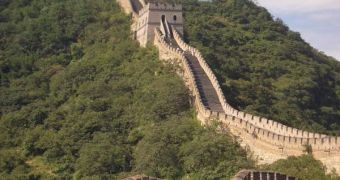The Great Wall of China is actually a large collection of defensive constructions, which began to be built more than 2,000 years ago. The portions that can now be visited, located around the larger cities, are the most popular and well-preserved ones, but a two-year study by the State Administration of Cultural Heritage and the State Bureau of Surveying and Mapping has revealed an additional 2,551 kilometers (1,585 miles) of walls in the northern and western parts of the country. With the new additions, the total estimated length of the Great Wall has increased to 8,851.8 kilometers (5,500 miles), the DailyMail reports.
According to the two national agencies, the fragments that have been recently discovered span from the Hu Mountain, in the northern province of Liaoning, to Jiayu Pass, in the western Gansu province. They have been identified by experts working with GPS devices and infrared scanners, which have allowed them to accurately identify the buried wall. Over the centuries, sections of the defensive barriers have come under increased strain from the elements, with sandstorms relentlessly pounding at them.
After the 1950s, agricultural measures aimed at increasing production transformed large portions of land in the northern parts of the country into desert. Sandstorms generated here act like sandpaper and erode the old construction. The situation is actually pretty serious, because some Chinese officials expect fairly extensive portions of the wall to be totally eroded and transformed into mounds of gravel and sand within the next 20 years.
Some of the recently discovered wall portions have been hidden in river beds, as well as under cliffs and trenches. Their origin has been traced back to the Ming Dynasty, which ruled over China from 1368 to 1644. Still, the edifices were only the coronation of centuries of wall construction. The first stones were laid as far back as the 5th century BC, and the wall was continuously upgraded from then on. Most sections differ in age and construction method, and there are many that are not connected with each other.
China has been struggling to fix the wall for quite some time now, but no one really knows the extent of the damage to the structure. No surveys of the Great Wall have ever been carried out, but in some places experts already know that the state of the construction is miserable. In others, the wall runs the risk of collapsing, while, near the major cities, it's being constantly rebuilt.

 14 DAY TRIAL //
14 DAY TRIAL //